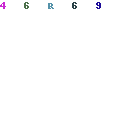Math master’s program winds up
One more semester to go and SIUE will add 25 more master’s level math teachers to the ranks of high school teachers in central Illinois. This is the result of hard work and dedication by two College of Arts and Sciences (CAS) professor’s, Marilyn Hasty and Tammy Voepel.
Associate professors of the Mathematics and Statistics Department, Hasty and Voepel have worked diligently over the past several years to create and fine-tune the program. According to Hasty, the program began with a planning grant that brought local high school teachers together to design a master’s level course for math education.

Charles Taylor, high school math, chemistry, and physics teacher will soon receive his master's in secondary education from SIUE. Taylor uses techniques learned in class to teach in Carlinville, IL.
“We had a planning grant before the main grant started and we had teachers from local school that helped us develop what it was that we wanted for course work,” said Hasty. “Now, we are working with 25 high school mathematics teachers and we are working on a master’s in secondary education with an emphasis on mathematics.”
Once the program began, the student’s pursuing their degrees helped to fine-tune the courses.
“The [high school] teachers that are in the program did not help develop the program, but what they have done is they have helped us see what works and what didn’t work in the classes so we could refine them,” said Hasty. “This summer, we will graduate 25 high school math teachers with their masters.”
One master’s student, Charles Taylor, a high school math, chemistry, and physics teacher in Carlinville, IL stated that the courses have helped him tremendously in teaching his courses. He said the courses have reminded him what being a student is like.
“The master’s program has helped me to be reminded of what it is like to be the student, and to ensure that the way I present my material, I am considerate of students abilities and accomodate for their learning. Also, it has refreshed as well as given me new knowledge in the field of mathematics,” said Taylor. “The most effective part of the program has been the open support from and willingness of the SIUE faculty to work with the program participants so that we can all succeed.”
The program was made possible with three grants from the federal government that were dispersed by Illinois state government.
“Nationally, it’s known as the Math-Science Partnership grant–a federal grant–and the money is actually awarded through the state. So each state gets the federal money and they funnel it down,” said Hasty.
Hasty stated that the three grants the program received were for $250,000, $250,000, and $99,000. The final year for the grant program is this year. The monies from the grants paid the majority of fees associated with a master’s in math education, including course and material fees, according to Hasty. The grants were designed to create a permanent course curriculum that future master’s students will be able to follow. Hasty stated that the grants served several important functions.
“One of the things we’ve done, we have developed some new math courses in the department that would meet the needs of these teachers–the kind of content that they need to be better teachers. We developed the courses and then put them through the courses,” said Hasty. “The other things we’ve done is we’ve had workshops for them to get them up to date on the new math standards and the new core curriculum standards that the state is adopting. So, we’ve tried to bring them up-to-date on what is going to be required of them in the future.

Taylor uses an iPad he received from the grant money to quickly pull up experiment examples in chemistry class.
The grants also allowed the participants to add to their classroom equipment.
“Through the grant, we’ve been able to provide them with some of the technology they use in the classroom. So they have some calculators, promethean tablets, clickers to use in the classroom. This spring, as the grant wound down, we asked them ‘what is it you need for your classrooms?’. So, they didn’t all get the same material. They got the material they need for their classroom. It was tailored to their needs,” said Hasty. “They were able to get the materials that would be needed to really enhance their classrooms.”
Taylor has been using his technology in and out of the classroom. He said he found the technology that he asked for to come in handy for himself and his students in ways he didn’t realize when he asked for it.
“The technology has been a great asset. I have used my IPad in physics and chemistry to demonstrate things. I have used the flip camera in my classes. I was able to let a student borrowed it to film a lecture they were going to. I used the sound recorder at the NCTM [National Conference of Teachers of Mathematics] conference to record the presentations that I attended. The laptop has been handy for transferring information between class, lab, and home, too, as well as typing up papers and other correspondences,” said Taylor.
The master’s program will continue without the backing of the grant. Hasty stated that she is confident because of how the ground work was laid that the program will continue to be successful.
Filed Under: Mathematics & Statistics












